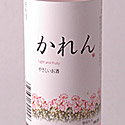On Friday, my first day in town, I managed to try five different sakés. Really, I was on a mission during this trip and I wasn't going to let silly thoughts such as, "should I really be drinking this early in the day??" slow me down.
The House
The House is in a nice little space right at the edge of Chinatown and North Beach. They offer only one saké by the glass, but it's a good one. I've had enough saké now (but I'm still unfamiliar enough with Japanese) that I am having a pretty difficult time keeping saké names straight. I didn't recognise Meibo "Yowanotsuki" junmai ginjo, which is also known as "Midnight Moon." When I got back to my computer and put two and two together I was excited because I knew that I had a bottle at home in my refrigerator. Something to look forward to! I was happy to make the discovery because I really like this saké. The aroma is pleasant with a bit of floral, the taste was clean with prominent apple throughout and a tart finish. It seems to be a good choice to match with a variety of foods, therefore not a bad choice for a restaurant to offer if they are only going to offer one by the glass. I had the white shrimp and Chinese chive dumplings which came with a tart, tangy sauce and the deep fried salmon roll with Chinese hot mustard. The House also offered a 750 ml bottle of San Pellagrino for $4.00 which I could hardly believe. Most places charge $4.00 for the little bottles.
Meibo junmai ginjo
Rice: Yamadanishiki polished to 50%
SMV +2
Alcohol 15.8%
Acidity 1.5
Amino Acid: 1.2
Ozumo
Later that night, I had a wonderful meal at Ozumo. This evening truly brought home to me the difference between "drinking" saké and "tasting" saké. At the beginning of the meal I wrote in my notebook: "Wakatake Daiginjo Onikoroshi (Demon Slayer) 'beautifully sound, round and alluring saké with a silky texture and slight sweetness stemming...'" The quote is from the menu and I didn't even finish writing the quote and that was it for the night. I was there with an old friend and the saké was flowing and, really, taking notes or even thinking logically about aromas and tastes was far from my mind. Well, I don't regret it. I can sort of recreate the evening from the itemized check: butternut squash miso soup, miso soup, bluefin sashimi, hamachi sashimi, spider roll, ikura sushi, Voss sparkling water, 1 glass Wakatake daiginjo, 1 glass Kamoizumi daiginjo, 1 glass Dewa 33, 1 glass Dewazakura Oka.
Dewa 33 & Dewazakura Oka specifics (also see True Sake's newsletter of April '06 for a good writeup of both):
Dewa 33
Polishing rate 50%
SMV +4
Alcohol 15.8%
Acidity 1.4
Dewazakura Oka "Cherry Bouquet"
Polishing rate 50%
SMV +5
Alcohol 15.5%
Acidity 1.2
Wakatake daiginjo (I later realized that this saké was recommended by one of my tablemates at Sake Day as his anytime saké and a brief search of the internet for other people's opinions shows that many others agree)
Polishing rate ?
SMV +/-0
Acidity 1.4
Kamoizumi daiginjo
Polishing rate ?
SMV 1.5
Acidity 1.2












